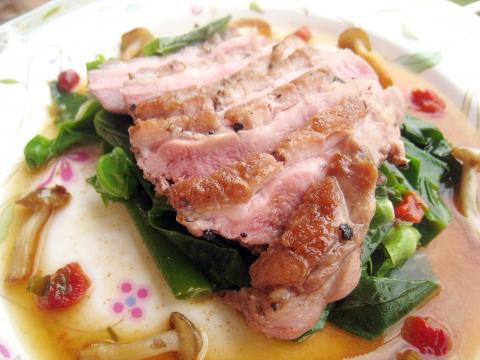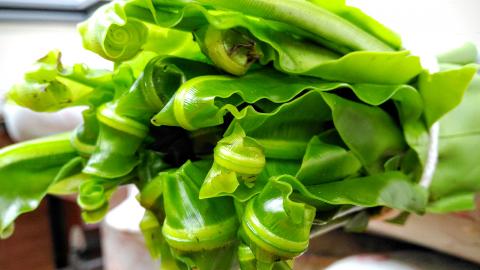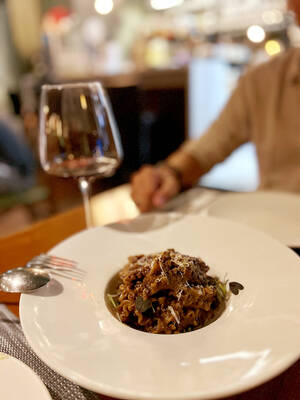I had never thought that eating bird’s nest fern (山蘇) was even a possibility until I came to Taiwan. This is a plant that is probably familiar to someone who has lived in Southeast Asia, but more likely as an ornamental plant than part of a living larder. It features strongly in the cuisine of local Aboriginal tribes, and has recently crossed over into the mainstream with considerable success. Although it’s now often cultivated for commercial sale, it still remains something of an exotic, retaining its “foraged” cred.
In my early and tentative exploration of Taiwan’s culinary culture, I bought into the idea that these foraged vegetables required special skills to prepare well. I enjoyed eating bird’s nest fern in restaurants that specialized in “wild” food, secure in the knowledge that preparation of this exotic morsel was best kept in the hands of specialists. After moving to Hualien, I was again confronted with the fern, and thought I would give it another chance. And it proved yet an eye opener. A little bit of care with washing the leaves and cutting away the more fibrous stems, and then there is no mystery at all. While not remarkably flavorful, they provide a lovely crisp crunch and are great for carrying other strong flavors.
One of the most common preparations of bird’s nest fern is fried together with salted dried anchovies and preserved cordia dichotoma (破布子). This preparation is widely available in restaurants and is a perfect accompaniment to a Taiwanese seafood meal.

Photo by Ian Bartholomew
The first thing to know about bird’s nest fern is to check that the leaves are perfectly green and have not been burnt by too much sunlight. The edible portion of the plant are the tender shoots, which are easily damaged, and when shopping at the market, you want to look for the deep and unblemished emerald green that really glistens on the plate.
Bird’s nest fern bought at the supermarket has usually been cleaned to some degree, but if purchased from a traditional market, it is best to check the leaves carefully, wiping off dirt and bugs that may adhere to the leaves — which will not be removed by a simple wash of water. As the texture is best with only a very rapid cooking, it is also advisable to cut away some of the thicker veins at the center of the leaf.
Blanching the leaves in salted water helps hold the lovely green color in any subsequent preparation. If you really want to keep things simple, just take the blanched leaves and top them with some mayo or a lighter dressing of sesame oil and soy, and you have a dish ready to go. They are also very nice deep-fried in a light batter.

Photo by Ian Bartholomew
In Taiwan, bird’s nest fern was traditionally considered a “mountain” vegetable, and therefore generally free from the worst excesses of chemical pesticide use. It is now widely grown in the plains as a secondary crop to betel nut by small scale farmers, which cannot but be a good thing. The plant has various uses as an herbal remedy in Southeast Asian folk medicine, thought to be a diuretic that is beneficial for bladder complaints. In Taiwan, it is widely thought of as having qualities that assist in the prevention of cancer.
While these claims await more scientific corroboration, as a wild vegetable that has yet to be subject to the tender mercies of agribusiness, bird’s leaf fern, if probably remarkably free of unwelcome tampering and is one of the healthiest veg options on the market right now. It is rich in calcium, iron and zinc, is a good source of protein and dietary fiber, and with its interesting texture, will also put some variety into your meals.
Bird’s Nest Fern with Duck Breast, Caper and Sweet Pepper Sauce
Recipe
(serves two)
Getting a crispy skin on a duck breast is best done by starting with a cold skillet and cooking over low heat to render the fat. That’s all good and well, but as we all know, the fat is where the flavor is, so what better than to use the oils and pan juices to make a sauce to flavor the meat and accompanying vegetables. Bird’s nest ferns provide this dish with a lovely crunch (make sure not to overcook them), and by blanching them they retain their vibrant green coloring.
Ingredients
2 small duck breasts (about 150g to 200g each)
Salt and pepper
Vegetable oil
1 small bunch of bird’s nest fern
1/4 cup white wine
1/2 tsp paprika
10 capers (in brine)
1/2 sweet red pepper, roasted and marinated (recipe follows)
Half a packet of white beech mushrooms
(鴻喜菇)
Salt and pepper / Method
1. Take the duck breast out of the refrigerator and allow to reach room temperature. About 1 hour.
2. Prepare the bird’s leaf fern by first washing the leaves thoroughly and cut away the thickest stems and discard.
3. Bring a pot of lightly salted water to a boil and blanch the leaves for about 1 minute. Remove from water and drain. Set aside.
4. Take the duck breast and score the fat in a hatch pattern with a sharp knife. This will help the fat render. Season liberally with salt and pepper.
5. Put about a teaspoon of vegetable oil in a cold pan. Place the duck skin-side down in the pan, smearing the oil. Turn to a low heat and cook slowly without moving the duck, though pressing down on the edges to make sure the whole skin is pressed against the pan.
6. Cook until internal temperature reaches 46 degrees Celcius, about 20 minutes, by which time the skin should be crisp and golden (cooking time will vary considerably depending on the size of the breast). Turn over and cook the meat side for about 2 to 3 minutes, bringing the temperature to 52 degrees Celcius. Remove from pan and rest for at least 5 minutes.
7. While the duck is cooking, mince the capers and roughly chop the roasted red pepper.
8. Heat oil in a large frying pan over medium heat. Throw in the mushrooms, making sure not to crowd the pan. Sprinkle with sea salt. Fry, stirring occasionally, until the mushrooms get a nice burnish of golden brown.
9. Pour off excess oil from the pan used to cook the duck, retaining about 3 tablespoons. Bring to medium heat and deglaze the pan with white wine, using a wooden spoon to free up any bits stuck to the base (there is loads of flavor in these often neglected brown bits at the bottom of the pan).
10. Reduce by about half. Throw in the capers and red peppers. Add the blanched bird’s nest fern and paprika. Stir over medium heat to coat the leaves.
11. Place the bird’s nest fern on the plate. Thinly slice the duck breast and place over the vegetables. Pour over the remaining liquid and garnish with the mushrooms.
For the red peppers
There are many ways of removing the membrane from the bell pepper from steaming to toasting over an open flame. If you have an oven, roasting is probably the least troublesome, and also provides a lovely smoked quality to the flavor. Using a broiler is quicker, but you really have to be on top of the process in case the peppers don’t just char, but burn right through.
Ingredients
1 large or 3 small bell peppers
1/2 cup rice vinegar
1 tbsp salt
Olive oil
Directions
1. Preheat the oven to 220 degrees Celsius.
2. Wash the peppers thoroughly and place on a baking sheet.
3. Place in the top third of the oven. Cook for 20 minutes and rotate. Cook for another 20 minutes. The skin should be blackened and puffy.
4. Remove from the oven and cover with foil, allowing the peppers to cool gradually in their own steam. This greatly facilitates the process of removing the skin.
5. Peel off the thin outer membrane and remove the seeds. Do not wash the peppers at this point, as this will remove much of the flavor.
6. Put the vinegar in a bowl. Prepare another bowl or storage jar. Have the salt standing by ready to use.
7. Dredge the pieces of bell pepper in vinegar and then lightly salt. Place in the prepared jar. Do this will all the peppers. Discard the excess vinegar. You should have some liquid remaining from the cooked and peeled peppers. Pour this over the salted peppers. Add olive oil to top up and cover.
Ian Bartholomew runs Ian’s Table, a small guesthouse in Hualien.
He has lived in Taiwan for many years writing about the food scene and has decided that until you look at farming, you know nothing about the food you eat. He can be contacted at Hualien202@gmail.com.

Last week gave us the droll little comedy of People’s Republic of China’s (PRC) consul general in Osaka posting a threat on X in response to Japanese Prime Minister Sanae Takaichi saying to the Diet that a Chinese attack on Taiwan may be an “existential threat” to Japan. That would allow Japanese Self Defence Forces to respond militarily. The PRC representative then said that if a “filthy neck sticks itself in uninvited, we will cut it off without a moment’s hesitation. Are you prepared for that?” This was widely, and probably deliberately, construed as a threat to behead Takaichi, though it

Nov. 17 to Nov. 23 When Kanori Ino surveyed Taipei’s Indigenous settlements in 1896, he found a culture that was fading. Although there was still a “clear line of distinction” between the Ketagalan people and the neighboring Han settlers that had been arriving over the previous 200 years, the former had largely adopted the customs and language of the latter. “Fortunately, some elders still remember their past customs and language. But if we do not hurry and record them now, future researchers will have nothing left but to weep amid the ruins of Indigenous settlements,” he wrote in the Journal of

Even after years in business, weekend tables here can be booked out a month in advance. The price point far exceeds its competitors. Granted, expectations are soaringly high, but something here failed to hit the high notes. There are a few telltale signs that a restaurant relies solely on outstanding food to create the experience, no gimmicks or distractions needed. La Mole is such a restaurant. The atmosphere is food-forward, with an open kitchen center stage. Our tables are simple; no candles, no dim lighting, no ambient music. The menu is brief, and our waiter directs most

If China attacks, will Taiwanese be willing to fight? Analysts of certain types obsess over questions like this, especially military analysts and those with an ax to grind as to whether Taiwan is worth defending, or should be cut loose to appease Beijing. Fellow columnist Michael Turton in “Notes from Central Taiwan: Willing to fight for the homeland” (Nov. 6, page 12) provides a superb analysis of this topic, how it is used and manipulated to political ends and what the underlying data shows. The problem is that most analysis is centered around polling data, which as Turton observes, “many of these